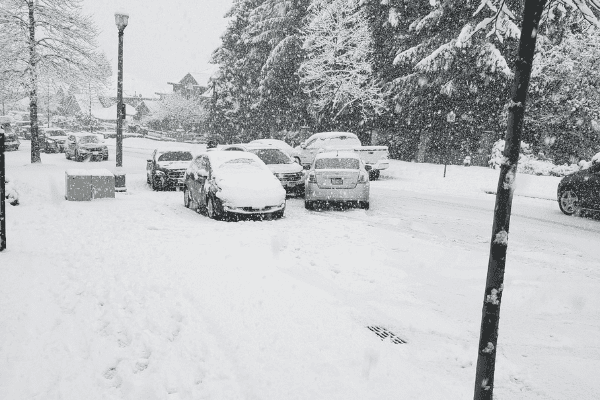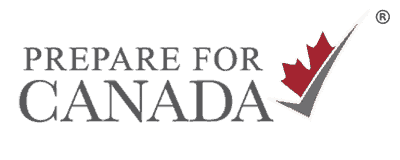
Winter in Canada can be a big cause of concern, especially if you have recently arrived in Canada and have never driven in snow. Even though winter officially arrives on December 21st, it’s not uncommon to see heavy snowfall, slush, and ice arrive in early November. As beautiful as winter in Canada can be, driving in hazardous winter conditions is much different. So check out these winter driving tips to increase your safety and the safety of others.
Prepare Your Car for Winter in Canada
Winter driving is much different than driving in summer conditions, so you have to prepare your car. With this checklist, you can ensure you and your car are ready for safe winter driving.
| WINTER DRIVING CHECKLIST |
|---|
| ✓ Install four winter tires |
| ✓ Test your car battery |
| ✓ Check your headlights and replace them if necessary |
| ✓ Ensure your wiper blades are in good working condition |
| ✓ Place a snowbrush and icescraper in your car |
| ✓ Check the fluid levels |
| ✓ Buy extra washer fluid to keep in your car and check that it’s rated for -40 degrees Celsius |
| ✓ Keep your gas tank at least half full to prevent the fuel-line from freezing and your car from starting |
Installing Winter Tires
Winter tires are essential for driving in hazardous conditions and they exceed specifications for grip and traction. A specialized rubber compound helps winter tires adapt to the road surface and dig into snow and ice. This added traction allows the tires to adapt to winter conditions and grip the road without sliding. Winter tires also improve stability and help you handle your car with greater control when driving on snow-covered roads or changing lanes in slush or on ice.
According to the Canadian Automobile Association, you should switch to winter tires as soon as the temperature is consistently below 7 degrees Celsius. Most automotive service centers or auto body shops in Canada can install winter tires or offer tire-changing services.

Check Winter Weather and Road Conditions Before You Driver
Advertisement:
During the winter in Canada, driving can be unpredictable, and you may be unable to avoid a sudden snowstorm. However, if you check weather websites for local and regional forecasts, you’ll be in a better position to delay or change your travel plans. When a snowstorm is in the forecast, it’s best to stay off the roads entirely.
The Weather Network provides essential severe weather outlooks and issues warnings and alerts for snowfall and freezing rain risks.
Or, you can also access the 511 app in winter to check for weather and road conditions before heading out:
British Columbia Traveller Information System
Advertisement:

Related Posts:
Prepare a Driving Survival Kit for Winter in Canada
In addition to preparing your car, it’s also wise to prepare for your comfort and safety if your car breaks down. Consider adding these provisions to your vehicle:
| VEHICLE PROVISIONS TO PREPARE FOR WINTER DRIVING |
|---|
| ✓ First aid kit |
| ✓ Extra clothing and footwear |
| ✓ Blanket |
| ✓ Non-perishable such as granola bars, dried foods, juice, and bottle water |
| ✓ Matches |
| ✓ Flashlight |
| ✓ Cell phone and charger |
Clear Snow and Ice from Your Car
Another critical winter driving tip is to make sure you clear your car of snow and ice. That handy snowbrush and ice scraper that you have in your car will help you to see clearly from all windows.
You also want other cars to see you, so make sure to scrape ice from all windows, and brush the snow from the hood and roof of the car. Snow left on the roof of a car can slide down to the windshield and obstruct your vision. When you clear snow from your car, you’ll avoid snow blowing from your car when driving, Blowing snow from your car can impede your vision and that of other drivers on the road.
Remember to add some extra time to your schedule to properly remove snow from your car.

Driver Behaviour is Also Important When Driving in Winter
Winter driving is stressful and as a driver, you need to be alert to changing conditions. Ensure you give yourself plenty of time to arrive at your destination and reduce your driving speed. It takes a longer time to stop on snow and ice-covered roads.
Drivers must also be aware of snow plows on the road. In Ontario, it’s now illegal to pass snow plows working side-by-side on multi-lane highways. This is a Highway Traffic Act violation that could result in fines ranging from $150 to $1,000.
Leave Lots of Space When Driving in Winter

While it makes sense to always keep plenty of space between your car and the one in front of you, it can be a lifesaving winter driving tip in Canada. A helpful guideline is to keep a minimum of three car lengths between the car that you are driving behind. Or, try to keep eight to ten seconds between you and the car you are following.
You can measure the seconds by watching the car ahead of you pass a fixed object such as a road sign or fence. Then you count how long it takes for you to pass the same object. If your travel time is less than three or four seconds, it’s time to increase your distance from the car in front of you.
And more space is always better when driving in a snowstorm. The proper amount of space will allow you plenty of time to brake safely.
When you brake quickly, your car can easily lose traction. It’s best to keep your speed down so you can avoid slamming on the brakes. It’s harder to stop your car in snow and icy conditions.
Watch Out for Black Ice
Black ice is another danger when driving in winter in Canada, or even when there is freezing rain. It’s difficult to see because the ice is clear and almost the same colour as the road, (therefore, the name for black ice).
This dangerous driving condition happens when the road is wet and the temperature drops below freezing. Black ice is common in locations such as bridges and overpasses where the cold air flows below the surface of the road.
This road sign shows a vehicle with skid marks to indicate that the pavement is slippery when wet. This indicates that there is an increased risk of car accidents.

If you do hit black ice, follow these winter driving tips:
- Keep your steering wheel straight to avoid sliding or losing control of your car
- Avoid braking because it will cause your car to slide
- Take your foot off the gas pedal to reduce your speed and let the car stop on its own
- Know how to use the anti-lock brake system (ABS) if your vehicle has it.
Slow Down When Driving in Winter in Canada
You can expect a few big snowstorms each winter in Canada. And, it can be very frustrating when you have to get somewhere during a storm. Traffic slows down, snowplows are busy salting, plowing, and removing snow, and people are impatient.
The best advice is to give yourself plenty of time if you absolutely must be on the road during a snowstorm or freezing rain. Your patience will help you to stay calm, make smart decisions, and be aware of other drivers on the road. Remember, driving in winter in Canada is stressful for everyone. But, when you follow these smart winter driving tips, the roads will be safer for everyone.
For more information, tools, and free webinars about living in Canada visit our Settling in Canada resource page. We’ll help you to settle in Canada successfully!

